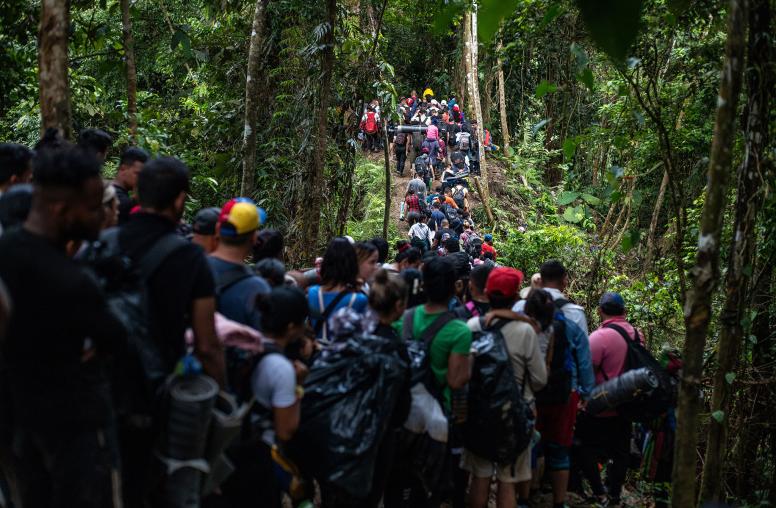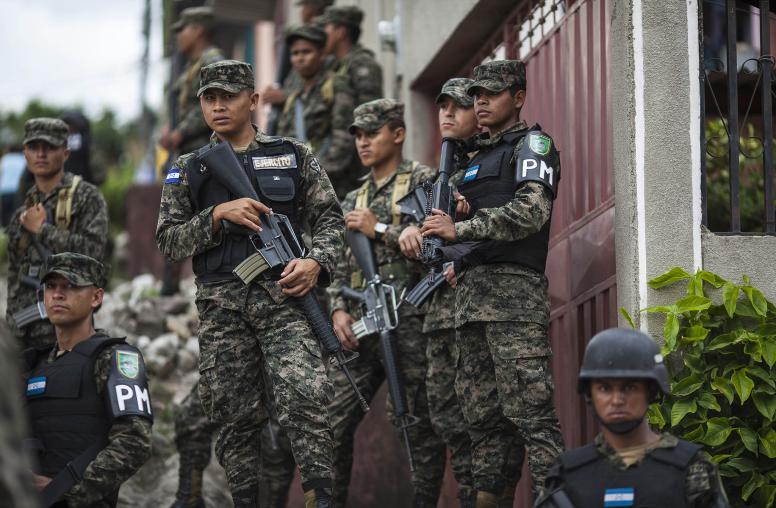Central America: To Slow Refugees’ Flight, Reduce the Violence
Bloodshed in El Salvador, Honduras and Guatemala must be addressed on every front—like an epidemic disease.
The Central American violence that is driving refugees to the U.S. border is fueled by corruption, drug trafficking, gang culture and poverty—an interlocking pathology of ills that must be treated on multiple fronts, like an epidemic disease, say specialists on the region. Halting the bloodshed in El Salvador, Honduras and Guatemala will be difficult, but can be achieved with a broad approach, experts said in a discussion at the U.S. Institute of Peace.

The discussion was held by USIP and the Conflict Prevention and Resolution Forum, a group that includes the Institute and six other Washington-based organizations that work against violent conflict abroad. The past two years have seen a surge in people seeking asylum at the U.S. border, saying they are fleeing life-threatening violence in the three countries of Central America’s “Northern Triangle.” As the U.S. works through the refugees’ declarations and policies to evaluate them, questions of what can be done to prevent their flight in the first place—and to ease the suffering of populations with close ties to the U.S.—become increasingly urgent.
Violence in the three nations has displaced more than 1 million people, and refugees have poured abroad to seek asylum—294,000 by last December, a 58 percent increase in just one year. Central America became a key area of U.S. concern in the late 1970s, when conflicts and revolutions broke out across the region. U.S. assistance spiked during that period, and again in the early 2000s, in face of new violence. Much of that funding was devoted to countering narcotics trafficking rather than to general security and development. Now, as a new wave of violence escalates in Central America, the panel explored how U.S. efforts might help curb it.
Violence: More than Gangs
Policymakers and others need to see that the region’s problem is broader than simply gang violence, said Lisa Haugaard, the executive director of the Latin America Working Group, an advocacy organization for Latin American civil society activists.
“Yes, gangs are devastating with forced youth recruitment, extortion and so forth, but it’s only one kind of violence,” Haugaard said. A wider lens would include organized, transnational crime linked to public corruption; massive looting of government programs, such as Honduras’s health system, and the harm to citizens; attacks on land and environmental rights activists pushing for more equitable development; domestic violence; and extrajudicial executions by security forces that erode the rule of law and trust in government.
“To address gang violence, we have to address these others as well,” she said.
A broadened approach to the Northern Triangle also requires looking at how U.S. policy intersects with security strategies. For example, successful U.S. pressure for protection of human rights would likely help build confidence in law enforcement.
Immigration policy needs to support violence prevention programs, too, Haugaard said.
Effects of U.S. Policies
The U.S. government should think carefully about how Honduras and El Salvador might be affected by the planned termination of the Temporary Protected Status of about 300,000 of their citizens, granted after long-ago natural disasters, Haugaard said. Most of these people have established lives in the U.S. and send home remittances that help their communities. Returning them to their countries of origin would be “counter-productive,” she said. (A federal judge has temporarily blocked termination of the program.)
The outsized internal security role of military forces in the Northern Triangle is counter-productive, said Adam Isacson, the director of defense oversight at the Washington Office on Latin America, a research and advocacy group. Repeatedly, soldiers trained for combat end up in the streets to do an emergency job for which they have no preparation—and are seldom withdrawn afterwards, he said. Police forces, meanwhile, remain inadequate. Despite some reforms in the 1990s, demanded by international donors, police are underpaid, riven by corruption, have weak internal controls and lack a professional track for experienced officers to rise in the ranks.
U.S. programs and some “enlightened” elected governments have made progress in law enforcement, Isacson said. He cited efforts in community policing, “hotspot” policing, model precincts, some prison reform and steps toward improving the judiciary. At the same time, he said, some U.S. influences constrain progress. U.S. demand for illegal drugs continues unabated; American gun policies allow weapons to stream south to Central America; money from trafficking and corruption flows through U.S. banks into Florida and Texas real estate. On the local level, low tax collections leave police forces underfunded, and police officials can break laws with impunity.
Seeking Data for Solutions
The U.S. Agency for International Development is assessing data and seeking more as it contemplates next steps in the Northern Triangle, said Steve Olive, a senior USAID official for Latin America. National-level statistics can be deceptive, he said. In Guatemala, for example, 50 percent of homicides take place in 20 of the country’s 340 municipalities. In Honduras, 40 percent of murders occur in three of the nation’s 298 municipalities. Efforts might be aimed narrowly at those trouble spots, he said.
The moderator of the panel, USIP’s Steve Hege, said recorded homicides are an inadequate proxy for violence. Many people simply “disappear,” while homicides are counted only when bodies show up. More importantly, measurements of violence should include the levels of anxiety and fear in communities and the degree of public trust in law enforcement, he said.
“Violence prevention is the backbone of USAID’s security programs because it works,” Olive said. The agency has learned that significant benefits can be derived from intervention with high-risk individuals, low-cost youth outreach, community policing and small infrastructure improvements—which together “dramatically lower crime victimization rates.”
Seeds for change are present in the Northern Triangle but their growth is stifled by poor coordination among donors, implementers of assistance programs and national governments, said Enrique Roig of Creative Associates International, a development consultancy that has run a violence prevention project in five high-risk municipalities in Honduras. His organization, like USAID, seeks to employ a public health approach, with a focus on programs that have worked in the U.S. including alternative opportunities for youth, family counseling, and cognitive behavioral therapy, Roig said.
“We have seen improvement in data collection and understanding on risk levels and being able to pinpoint specific interventions,” Roig said. “The biggest challenge is how we put all these things together.”


